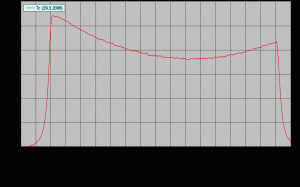Observatory and Planetarium Plzen was an organizer of two solar eclipses expeditions, both in 2005 and 2006. The first expedition took place in the end of September 2005; its target was observing an annular solar eclipse near Spanish town Alicante, which occurred on the 3rd October 2005. Expedition to southern Turkey was organized in March 2006, there was possible to observe a total solar eclipse on the 29th March 2006 here.
The meteorological experiment was included in expert programmes of both expeditions; its target was measurement of the meteorological and physical quantities during these astronomical phenomena.
Post processing of the measured data from the expeditions mentioned above was the main issue of work; its name is „The Changes of Meteorological and Physical Quantities during Annular and Total Solar Eclipse“. The work was intended for the contest Secondary Scholar Activity in the Czech Republic and it won in the branch of 02 Physics on National Competition 2007 in Prostejov.
Its target was realization of the first detailed description of the changes in the progressions of the meteorological and physical quantities during annular and total solar eclipse and consecutive comparison of these kinds of solar eclipse in the light of it.
Solar Eclipse Meteorological Measurement
Meteorological measurements were carried out within frame of the Solar Eclipse Meteorological Measurement (SEMM) project, which has existed at Observatory and Planetarium Plzen since 1998, when all the devices intended for measuring of the intensity of the illumination and the temperature of the air during total solar eclipse in August 1999 were made by Vaclav Svab and Bc. Jiri Hofman. The second generation of the measuring devices was ensued in 2001; the devices had higher resolution and accuracy. They were used during total solar eclipse in Angola and Zambia in that year. Three identical weather stations of the third generation were developed between 2001 and 2005. They were firstly used during annular solar eclipse in Spain in 2005 and total solar eclipse in Turkey a year later.
The amount of the measured quantities was expanded during construction of the measuring devices of the third generation of the SEMM project (e.g.: the colour of the solar radiation, the temperature of the soil at 5 cm under the ground or wind speed and direction). (The total view of the measured quantities can be found in the work in the chapter no. 2.3). The accuracy and sensitivity of the measurement were also improved. Measured values are recorded with the 10s periodicity, but the rate drops down to as little as 1s period during the 30 minut period around the total (annular) phase of a solar eclipse. This makes possible to acquire large amount of information about actions at the bottom layer of the atmosphere during total respectively annular phases of solar eclipses. The capacity of the accumulators (c. 50 h of operation) has also increased for maintenance of the mobility and the energetic independence of the devices. Observatory and Planetarium Plzen led by Mr. Lumir Honzik who covered kindly construction of the devices mentioned above financially and methodically.
Decision was made to carry out calibrations of all measuring modules of the third generation devices of the SEMM project considering experiences during the previous measurements to get the new calibrating constants. To do the calibration the Laboratory of the Czech Hydro Meteorological Institute in Prague-Libus was used.
Photo no. 1: The Weather Station of the Third Generation of the SEMM Project
The Progressions of the Measurements
The three weather stations were used during expedition to observe the annular solar eclipse in Spain and they were located in the line, which was upright toward the central line of the annular path which is the area where it is possible to observe annular solar eclipse. Only data from the weather station located the nearest toward the central line in 90% depth of the annular path were processed considering orientation of the work. The long-term weather forecast by Fred Espenak (NASA) and Jay Anderson (NASA), accessibility of the site and financial possibilities of the members of expedition were taken into account during the choice of a suitable observational site.
The observational site was located in the eastern Spain in the neighbourhood of Alicante town. Its geographical co-ordinates were: φ = 38° 36′ 20,4“ N; λ = 00° 02 ‚28,2“ W; altitude: 0 m The weather station was operated by Petr Masek and Jan Vit. Two measurements were arried out there. The first one took place on the annular solar eclipse (October 3rd, 2005) day and the second one (2nd referential) had been accomplished one day after the phenomenon (October 4th,2005). Due to the lack of time the 1st referential measurement on the 2nd October 2005 was not accomplished. The operating staff did not accomplish records about meteorological situation at the place, which made the processing of the measured data difficult.
Only one observational site located almost on the central line of the total paths was created during the expedition to Turkey. Its choice was influenced by the long-term weather forecast by Fred Espenak (NASA) and Jay Anderson (NASA), the weather statistics by RNDr. Martin Setvak, CSc. (the Czech Hydro Meteorological Institute) and financial possibilities of the members of expedition too.
Town Side located on the southern coast of Turkish Republic was chosen as suitable observational site for astronomical observations and the meteorological experiment. The geographical co-ordinates of the observational site were: φ = 36° 46’48,2“ N; λ = 31° 23′ 20,8“ E; altitude: 2 m. Service of the weather station was created by Lumir Honzik, Miloslav Machon, Martin Adamovsky and Ondrej Trnka. Two measurements were accomplished during this solar eclipse too. The first (1st referential) one was carried out on day before the total solar eclipse (March 28t, 2006). Unexpected technical problems appeared during the launching of the device, so the measurement was manually set on with periodicity of 10 s records throughout all measurement time. The second measurement was carried out on the eclipse day (March 29th, 2006) and no problems occurred during the start of the measurement. The passage of the warm front above the observational site caused the marked change of meteorological situation, so the second refrential measurement was not accomplished.
Data Processing and Its Interesting Results
The application Microsoft R Excel 2003 was used for the processing of the measured data. The measured values were rounded-off and the graphs were smoothed by trend lines of the movement averages with appropriate periods before the numerical and graphical data processing. The curves were described by time intervals and the fundamental arithmetic and statistics operations were used during numerical processing.
There are only some interesting quantities mentioned below considering the limited extent of the article, whole processing can be found in the work.
Processing of the intensity of the global solar radiation confirmed that the quantity has decreased during both solar eclipses. Indeed the numerical processing showed very high and interesting difference of the amount of the decrease between these solar eclipses. Silicon photodiodes were chosen to sense this quantity. They were installed inside of cases that ensured the cosine correction of the sensors with front-end filters.
The value of the intensity of the global solar radiation decreased about 8 times to compare to the value before the beginning of the phenomena during the annular solar eclipse in Spain, the eclipse magnitude was 95.2%. Value of this quantity decreased about cca 41000 times in comparison to the value before the beginning of the solar eclipse during total solar eclipse in Turkey with its magnitude 105.0%.
The measurement showed differences in the times of maximal phases of the solar eclipses mentioned in the predictions. The size of the difference between predicted time and measured time of the minima of the global solar radiation was 48.6 s during annular solar eclipse. The value of this difference was 5.5 s during total solar eclipse.
The measurement of the air’s temperature at 2 m above the ground and its consecutive processing showed the decrease of this quantity during annular and total solar eclipse too. The quantity was sensed by a resistance sensor Pt 1000.
The amount of the quantity’s decrease was again higher during total solar eclipse (about 0.4°C) than during annular solar eclipse. The result showed fact that the amount of the decrease of the temperature at 2 m above the ground increases respectively decreases with the magnitude of solar eclipse.
A certain influence of the heating capacities of the Earth’s surface and the air was shown during the processing which showed mainly delay of all measured temperature minima toward the minimum of the intensity of the global solar radiation (for more detailed information see the chapter no. 6.6 of the work).
The correlated colour temperature of the solar radiation is one of the ways how to express the colour of the measured radiation. The acquired results are one of the most interesting points of this project considering the fact that the quantity is not usually taken into the account during the meteorological-physical measurements during solar eclipses. The colour of the solar radiation was sensed by a RGB colorimeter, the size of viewing field is 180°.
Processing of this quantity showed that its progression is different during an annular and a total solar eclipse.
Graph no. 1: The Correlated Colour Temperature of the Solar Radiation during the Annular Solar Eclipse
Total blockade of the direct solar radiation does not occur during an annular solar eclipse and light from marginal areas of solar disc strike on the observational site. These areas appear darker in consequence of limb darkening phenomenon. The incident radiation has got lower value of the correlated colour temperature which means that there is higher amount of red photons there.
Graph no. 2: The Correlated Colour Temperature of the Solar Radiation during the Total Phase of the Solar Eclipse
The situation is opposite during a total solar eclipse because of the total blockade of direct solar radiation. Diffused solar radiation strikes upon the measuring sensors only during total phase. It has got higher value of the correlated colour temperature in consequence of the Rayleigh’s diffusion and it contains higher amount of the blue photons. The shape of the curve representing the correlated colour temperature was caused by shape of the horizon, the presence of boundary-line between the sea and the land respectively the aerosols in the air.
The comparison of the measured data and colour temperature of the solar corona acquired from digital photos of the total solar eclipse by a worker of Observatory and Planetarium Plzen Ing. Jiri Polak showed the fact that coronal light does not appear markedly during sensing of sky colour using that large viewing field.
The measured data of the quantity showed small differences between predicted and measured times determining the beginning and the end of total phase of the solar eclipse.
(Analysis of the colour of the solar radiation in sRGB colour space is also mentioned in the work.)
The speed and the direction of the wind are other extraordinary measured quantities during a solar eclipse that describe the flowing of the air above the observational site. The wind speed was measured by the cup anemometer; the wind direction was sensed by the wind vane. The measuring module measures only the horizontal element of the wind.
The marked and short-time decrease occurred shortly after the maximal phases of both kinds of solar eclipses. This phenomenon was probably caused by the astronomical phenomena themselves, because of the decrease of the temperature respectively pressure gradient between the observational site and its neighbourhood.
The change in the wind direction was also noticed during the annular and the total solar eclipse. It has got long duration during annular solar eclipse and the fact that it was caused only by solar eclipse is not probable considering the duration of the phenomenon itself.
The markedly shorter change in the wind direction was measured out during the total solar eclipse which could on the other hand be caused by the phenomenon. In the connection with the decrease of the wind speed it could be connected to the beginning of formation of the high-pressure area above the observational site in comparison with the value of the atmospheric pressure above the sites besides of the eclipse path.
Conclusion
The processing of the measurement showed the fact that the marked differences in progressions of the meteorological and physical quantities exist between an annular and a total solar eclipse. It is possible to contend that the measurement by the devices of the third generation of the SEMM project introduced new results or specified known pieces of knowledge about the changes of these quantities during solar eclipses. It is possible then to consider the target of the work to be accomplished.
The acquired results can serve as basics for other activities concerned e.g.: the research of the Earth surface – atmosphere model, feedback of the atmosphere during rapid changes of the meteorological quantities or the research of the fauna and flora during solar eclipses considering the fact that the decrease of the electromagnetic radiation during a solar eclipse is an unique natural phenomenon by virtue of its speed and amount. The measured data could be important for education because the fundamental relations among meteorological elements can show the elementary dependencies of the measurements (e.g.: temperature and humidity of the air).
Current meteorology and astronomy do not pay much attention to these problems. It is desirable then to continue with these measurements which could be made possible by inserting the experiment to the expert programs of the eventual expeditions of Observatory and Planetarium Plzen to observe the total solar eclipses in Novosibirsk (August 1st,2008) and in Shanghai (June 22nd, 2009). It would be desirable to consider insertion of the measurement of the atmospheric pressure to this project. A sensing of the weather stations and its neighbourhood by cameras would help to make the processing of a measurement easier.
In the conclusion of the article I would like to thank the director of the Observatory and Planetarium Plzen Mr. Lumir Honzik, Mr. Vaclav Svab and Professor Mgr. Karel Martinek for their valuable guidance during this project. My thanks also belong to my parents for their financial support during my Solar Eclipse Expedition to Turkey in 2006. I would also like to express my thanks to Ing. Dalibor Boubin and Mr. Zbysek Ouhleda.
SEMM in pdf
MACHON Miloslav. The Changes of Meteorological and Physical Quantities during Annular and Total Solar Eclipse: Secondary Schholarly Actiity of the Czech Republic. Cheb: Grammar School, 2007.







